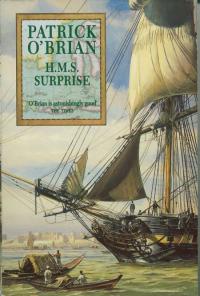The cover of HMSS shows the bow and foremast of the Surprise in harbor. The small boats and the distant shore suggest a far eastern locale, possibly Bombay. The ship appears to be moving from right to left.
The illustration as used for the books is actually reversed left to right from the Geoff Hunt original painting, to better accommodate the title block. It is not obvious, because ships are mostly symmetric, with little to distinguish starboard from larboard. The lieutenant standing on the forecastle has no epaulettes which could offer a clue.
However, the figurehead is a female figure wielding a sword in her left hand and a shield in her right. Not conclusive evidence, but a strong hint as to the mirror reversal. There is also the mainstay leading from the hidden mainmast to the bow at the foot of the bowsprit. This is a non-symmetrical feature, passing to the starboard side of the foremast. I don't know if there was a standard practice as to which side it passed the mast, and I have seen it drawn both ways in paintings.
The best clue for a sailor is the anchor cable leading from the hawse hole to the anchor ring. It is thick enough that we can see the direction of twist. It is righthanded, or Z twist, also known as hawser laid. An anchor cable, however, should be lefthanded, S twist, also know as cable laid.
A close look at the scene shows it to be one of great activity aboard ship, with numerous technical details displayed. They are in the process of hoisting the anchor aboard and setting sail. The bower anchor has been lifted clear of the water, and the anchor ring has been catted (the large hook attached to the projecting cathead). The cat tackle has a multiple block to aid in lifting the anchor up to the cathead. The two seamen are merely steering it into place. The heavy lifting is being done by unseen hands on the forecastle.
The single fellow to the right also has a hook and is standing next to a second projecting beam that looks much like a cathead. This timber does not appear in any other Hunt cover illustration; it is actually a temporary davit used only for weighing anchor, and is removed afterwards. The hook suspended from it is the fish, used to hook the fluke of the anchor. Once both ends of the anchor have been hauled up, it is lashed into place with ring-stoppers/cat-stoppers and a shank painter, and the two hooks are stowed.
Then the signal was made for the grand fleet to anchor,
And all in the Downs that night for to lie;
Let go your shank painter, let go your cat stopper!
Haul up your clewgarnets, let tacks and sheets fly!
We will rant and we'll roar like true British sailors,
We'll rant and we'll roar all on the salt sea.
Until we strike soundings in the channel of old England;
From Ushant to Scilly is thirty five leagues.
With the anchor clear, the ship is under way, with a hint of a bow wave. The fore topsail, which has three rows of reef points visible and slack starboard and larboard bow lines leading forward, is drawing, and it looks like the fore topgallant above is being unfurled. The forestaysail is set, and the foretopmast staysail is being unfurled.
One other note about the figurehead; it apparently is solely Geoff Hunt's creation, as it is not described anywhere in HMSS. For the movie, Peter Weir used a figurehead closely resembling this one.
© Don Seltzer

